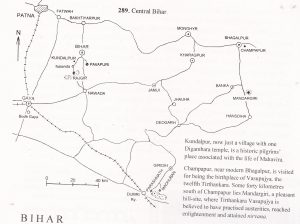Bihar
 Bihar – a name derived from vihara meaning temple – is the cradle of two great – religions: Buddhism and Jainism, the elder of the two. Its capital Patna, in olden times Pataliputra, was the political centre of India for nearly a millennium, from about 400 BC to 500 AD.
Bihar – a name derived from vihara meaning temple – is the cradle of two great – religions: Buddhism and Jainism, the elder of the two. Its capital Patna, in olden times Pataliputra, was the political centre of India for nearly a millennium, from about 400 BC to 500 AD.
Ashoka, the greatest king India has seen, ruled his vast empire from this city. Relatively much is known about ancient Bihar, thanks chiefly to Buddhist and Jaina sources, and travelogues written by Chinese pilgrims to the land of the Buddha, which have come down to us. There lies much unused material for historical novels and films. Coinciding with the militant expansion of Muslim rule to West and East Bengal (the latter now being Bangladesh), the land of Mahavira and the Buddha fell into oblivion.
Though Bihar’s present Jaina population amounts to only little more than twenty-seven thousand (1981), it contains within its borders some historic places which almost every Jaina, irrespective of sectarian leanings. longs to visit at least once in his or her lifetime; foremost those where Mahavira was born, lived and died, and above all Sammeta Shikhara (also known as Parashnath Hill), at an altitude of 1360 metres the highest mountain in Bihar.
